Predictive Suspension Algorithm for Land Vehicles over Deterministic Topography
Abstract
:1. Introduction
- Variable damping is the most common strategy in the development of semi-active suspensions, having different solutions:
- ○
- Hydraulic dampers with electrically controlled valves for adjusting the fluid flow rate from one chamber to the other [10].
- ○
- Magnetorheological [11] and electrorheological [12,13] dampers are similar to hydraulic dampers but they contain a magnetorheological or electrorheological fluid. This fluid, usually non-Newtonian, reacts to the application of magnetic or electrical fields and changes the properties of the damper. The use of these devices is widely spread in road and rail vehicles [14,15,16].
- ○
- Electromagnetic dampers take advantage of the known interaction between a moving coil and the magnetic field generated by a permanent magnet or electromagnet to generate a damping effect [17]. Karnopp studies the use of permanent magnet linear motors as variable mechanical dampers for vehicle suspensions [18].
- The third component of suspension systems, inertia, is modified through a variable inerter. The inerter is a mechanical device in which the force applied is proportional to the relative accelerations between the two terminals of the device [19]. These systems have been proposed to improve the comfort of rail vehicles [20].
2. Materials and Methods
2.1. Vehicle Model
2.2. Suspension Algorithm
- Reading (angles and vertical acceleration) and computing vertical velocity and position.
- Identifying the indexes i, m and f.
- Obtaining the actuated distance and refreshing the database.
2.3. Implementation in Simulink
3. Results
3.1. Profile Type 1
3.2. Profile Type 2
4. Conclusions
Author Contributions
Funding
Institutional Review Board Statement
Informed Consent Statement
Data Availability Statement
Conflicts of Interest
References
- Reimpell, J.; Stoll, H.; Betzler, J.W. The Automotive Chassis: Engineering Principles, 2nd ed.; Butterworth Heinemann: Oxford, UK, 2001; ISBN 978-0-7506-5054-0. [Google Scholar]
- Theunissen, J.; Tota, A.; Gruber, P.; Dhaens, M.; Sorniotti, A. Preview-Based Techniques for Vehicle Suspension Control: A State-of-the-Art Review. Annu. Rev. Control 2021, 51, 206–235. [Google Scholar] [CrossRef]
- Luo, R.; Shi, H.; Guo, J.; Huang, L.; Wang, J. A Nonlinear Rubber Spring Model for the Dynamics Simulation of a High-Speed Train. Veh. Syst. Dyn. 2020, 58, 1367–1384. [Google Scholar] [CrossRef]
- Anubi, O.M.; Patel, D.R.; Crane, C.D., III. A New Variable Stiffness Suspension System: Passive Case. Mech. Sci. 2013, 4, 139–151. [Google Scholar] [CrossRef] [Green Version]
- Kalyan Raj, A.H.; Padmanabhan, C. A New Passive Non-Linear Damper for Automobiles. Proc. Inst. Mech. Eng. Part J. Automob. Eng. 2009, 223, 1435–1443. [Google Scholar] [CrossRef]
- Solomon, U.; Padmanabhan, C. Hydro-Gas Suspension System for a Tracked Vehicle: Modeling and Analysis. J. Terramech. 2011, 48, 125–137. [Google Scholar] [CrossRef]
- Fu, B.; Giossi, R.L.; Persson, R.; Stichel, S.; Bruni, S.; Goodall, R. Active Suspension in Railway Vehicles: A Literature Survey. Railw. Eng. Sci. 2020, 28, 3–35. [Google Scholar] [CrossRef] [Green Version]
- Anubi, O.M.; Crane, C.A. New Semiactive Variable Stiffness Suspension System Using Combined Skyhook and Nonlinear Energy Sink-Based Controllers. IEEE Trans. Control Syst. Technol. 2015, 23, 937–947. [Google Scholar] [CrossRef]
- Sun, S.; Deng, H.; Li, W. Variable Stiffness and Damping Suspension System for Train. In Proceedings of the SPIE Volume 9057, Active and Passive Smart Structures and Integrated Systems 2014, San Diego, CA, USA, 9–13 March 2014; p. 90570P. [Google Scholar]
- Faraj, R.; Graczykowski, C.; Holnicki-Szulc, J. Adaptable Pneumatic Shock Absorber. J. Vib. Control 2019, 25, 711–721. [Google Scholar] [CrossRef]
- Spencer, B.F.; Dyke, S.J.; Sain, M.K.; Carlson, J.D. Phenomenological Model for Magnetorheological Dampers. J. Eng. Mech. 1997, 123, 230–238. [Google Scholar] [CrossRef]
- Gavin, H.P.; Hanson, R.D.; Filisko, F.E. Electrorheological Dampers, Part I: Analysis and Design. J. Appl. Mech. 1996, 63, 669–675. [Google Scholar] [CrossRef]
- Dixon, J. The Shock Absorber Handbook; John Wiley & Sons, Ltd.: Hoboken, NJ, USA, 2008; ISBN 978-0-470-51642-3. [Google Scholar]
- Mei, T.X.; Zaeim, A.; Li, H. Control of Railway Wheelsets—A Semi-Active Approach. In Advances in Dynamics of Vehicles on Roads and Tracks; Klomp, M., Bruzelius, F., Nielsen, J., Hillemyr, A., Eds.; Lecture Notes in Mechanical Engineering; Springer International Publishing: Cham, Swizerland, 2020; pp. 16–23. ISBN 978-3-030-38076-2. [Google Scholar]
- Yang, J.; Ning, D.; Sun, S.S.; Zheng, J.; Lu, H.; Nakano, M.; Zhang, S.; Du, H.; Li, W.H. A Semi-Active Suspension Using a Magnetorheological Damper with Nonlinear Negative-Stiffness Component. Mech. Syst. Signal Process. 2021, 147, 107071. [Google Scholar] [CrossRef]
- Tudon-Martinez, J.C.; Hernandez-Alcantara, D.; Amezquita-Brooks, L.; Morales-Menendez, R.; Lozoya-Santos, J.D.J.; Aquines, O. Magneto-Rheological Dampers—Model Influence on the Semi-Active Suspension Performance. Smart Mater. Struct. 2019, 28, 105030. [Google Scholar] [CrossRef] [Green Version]
- Soliman, A.; Kaldas, M. Semi-Active Suspension Systems from Research to Mass-Market—A Review. J. Low Freq. Noise Vib. Act. Control 2021, 40, 1005–1023. [Google Scholar] [CrossRef] [Green Version]
- Karnopp, D. Permanent Magnet Linear Motors Used as Variable Mechanical Dampers for Vehicle Suspensions. Veh. Syst. Dyn. 1989, 18, 187–200. [Google Scholar] [CrossRef]
- Smith, M.C. Synthesis of Mechanical Networks: The Inerter. IEEE Trans. Autom. Control 2002, 47, 1648–1662. [Google Scholar] [CrossRef] [Green Version]
- Lewis, T.D.; Jiang, J.Z.; Neild, S.A.; Gong, C.; Iwnicki, S.D. Using an Inerter-Based Suspension to Improve Both Passenger Comfort and Track Wear in Railway Vehicles. Veh. Syst. Dyn. 2019, 58, 472–493. [Google Scholar] [CrossRef]
- Kawamoto, Y.; Suda, Y.; Inoue, H.; Kondo, T. Electro-Mechanical Suspension System Considering Energy Consumption and Vehicle Manoeuvre. Veh. Syst. Dyn. 2008, 46, 1053–1063. [Google Scholar] [CrossRef]
- Klimenko, Y.I.; Batishchev, D.V.; Pavlenko, A.; Grinchenkov, V.P. Design of a Linear Electromechanical Actuator with an Active Vehicle Suspension System. Russ. Electr. Eng. 2015, 86, 588–593. [Google Scholar] [CrossRef]
- Kilicaslan, S. Control of Active Suspension System Considering Nonlinear Actuator Dynamics. Nonlinear Dyn. 2018, 91, 1383–1394. [Google Scholar] [CrossRef]
- Goodall, R.; Freudenthaler, G.; Dixon, R. Hydraulic Actuation Technology for Full- and Semi-Active Railway Suspensions. Veh. Syst. Dyn. 2014, 52, 1642–1657. [Google Scholar] [CrossRef] [Green Version]
- Goodall, R. Tilting Trains and Beyond-the Future for Active Railway Suspensions. 1. Improving Passenger Comfort. Comput. Control Eng. J. 1999, 10, 153–160. [Google Scholar] [CrossRef]
- Carballeira, J.; Baeza, L.; Rovira, A.; García, E. Technical Characteristics and Dynamic Modelling of Talgo Trains. Veh. Syst. Dyn. 2008, 46, 301–316. [Google Scholar] [CrossRef]
- Jamil, I.A.A.; Moghavvemi, M. Optimization of PID Controller Tuning Method Using Evolutionary Algorithms. In Proceedings of the 2021 Innovations in Power and Advanced Computing Technologies (i-PACT), Kuala Lumpur, Malaysia, 27–29 November 2021; pp. 1–7. [Google Scholar]
- Di Gialleonardo, E.; Facchinetti, A.; Bruni, S. Control of an Integrated Lateral and Roll Suspension for a High-Speed Railway Vehicle. Veh. Syst. Dyn. 2022, 1–27. [Google Scholar] [CrossRef]
- Rodriguez-Guevara, D.; Favela-Contreras, A.; Beltran-Carbajal, F.; Sotelo, D.; Sotelo, C. Active Suspension Control Using an MPC-LQR-LPV Controller with Attraction Sets and Quadratic Stability Conditions. Mathematics 2021, 9, 2533. [Google Scholar] [CrossRef]
- Palanisamy, S.; Karuppan, S. Fuzzy Control of Active Suspension System. J. Vibroeng. 2016, 18, 3197–3204. [Google Scholar] [CrossRef] [Green Version]
- Díaz-Choque, C.S.; Félix-Herrán, L.C.; Ramírez-Mendoza, R.A. Optimal Skyhook and Groundhook Control for Semiactive Suspension: A Comprehensive Methodology. Shock Vib. 2021, 2021, 8084343. [Google Scholar] [CrossRef]
- Boada, B.L.; Boada, M.J.L.; Vargas-Melendez, L.; Diaz, V. A Robust Observer Based on H ∞ Filtering with Parameter Uncertainties Combined with Neural Networks for Estimation of Vehicle Roll Angle. Mech. Syst. Signal Process. 2018, 99, 611–623. [Google Scholar] [CrossRef] [Green Version]
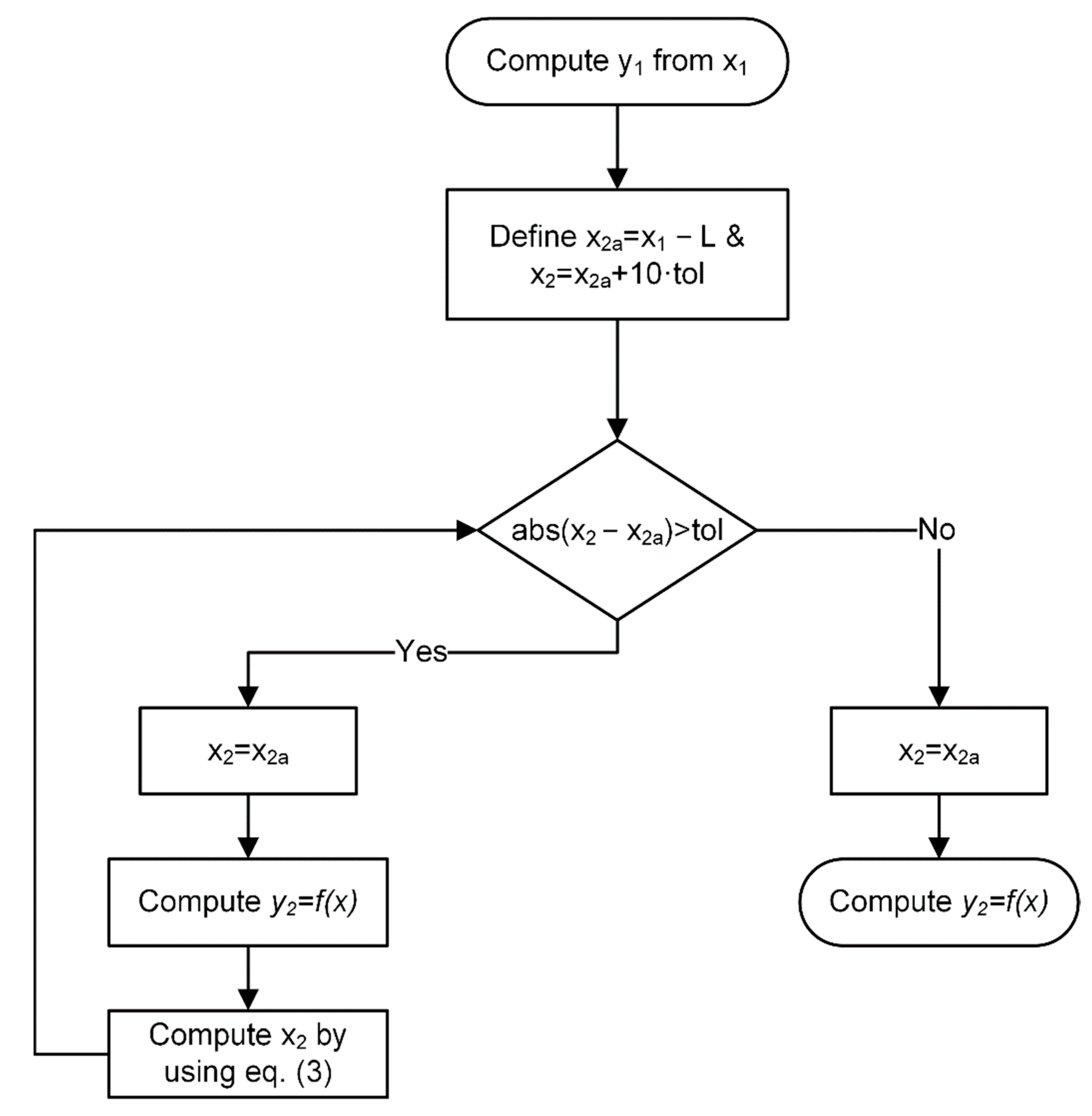
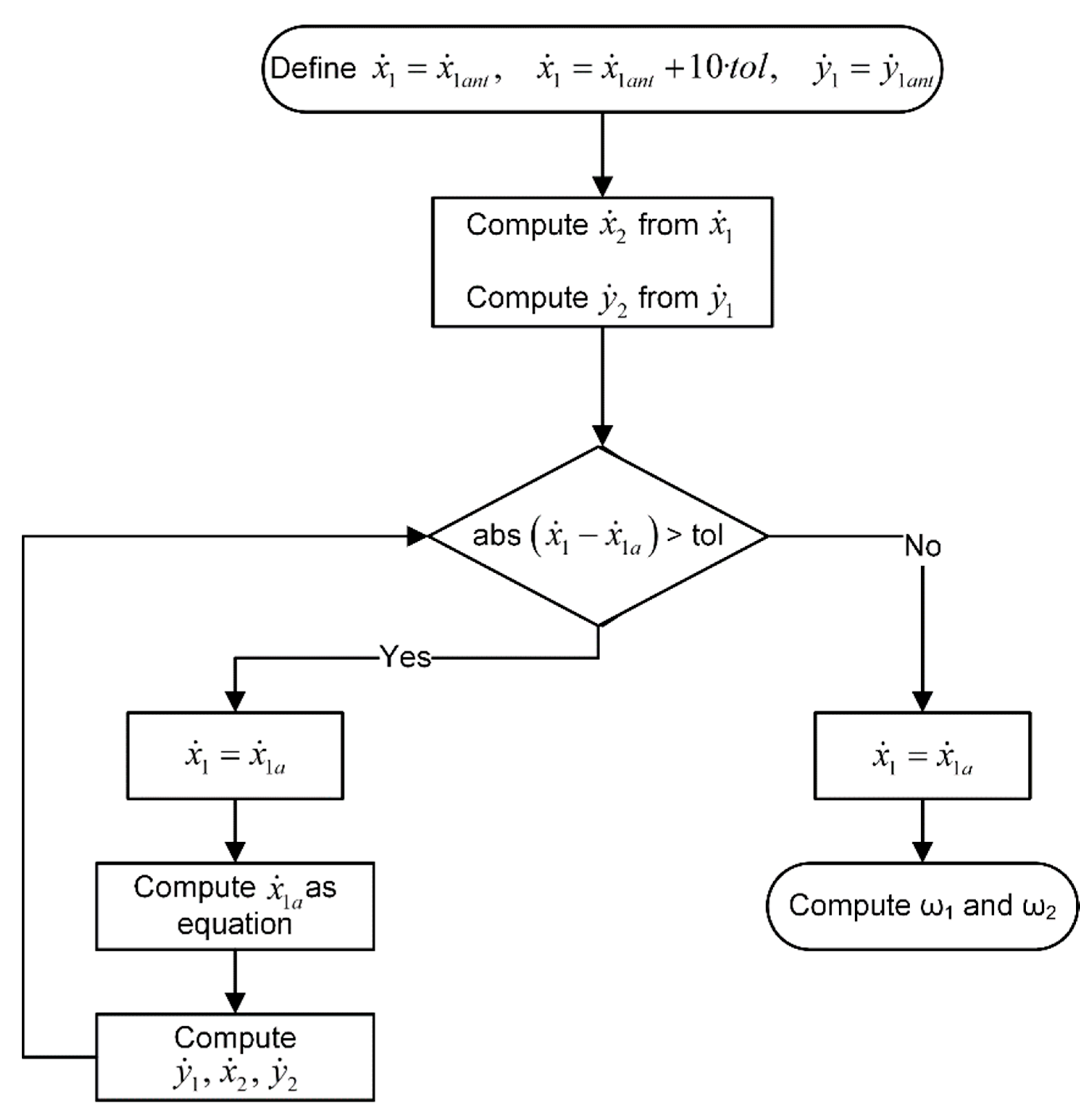
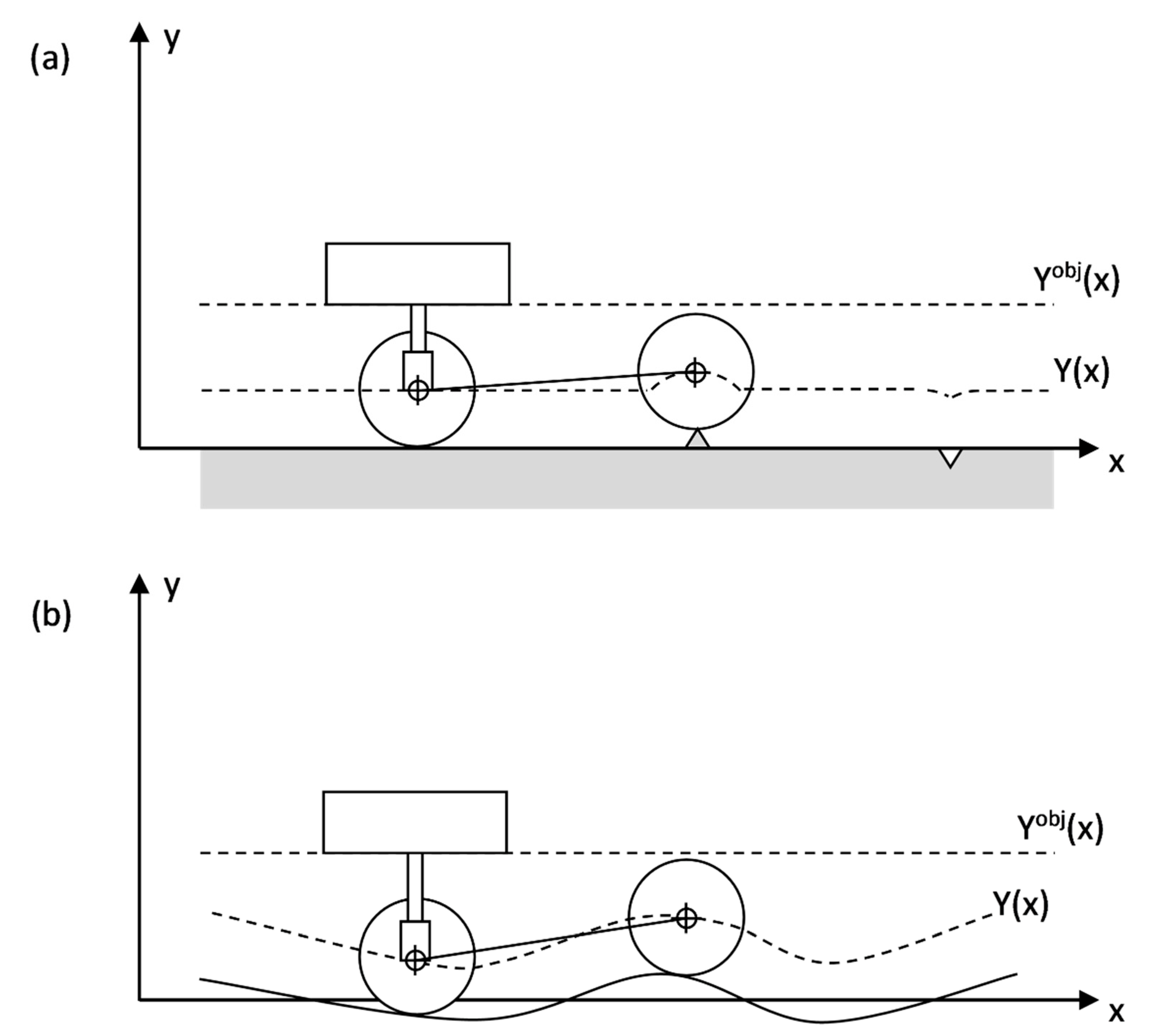

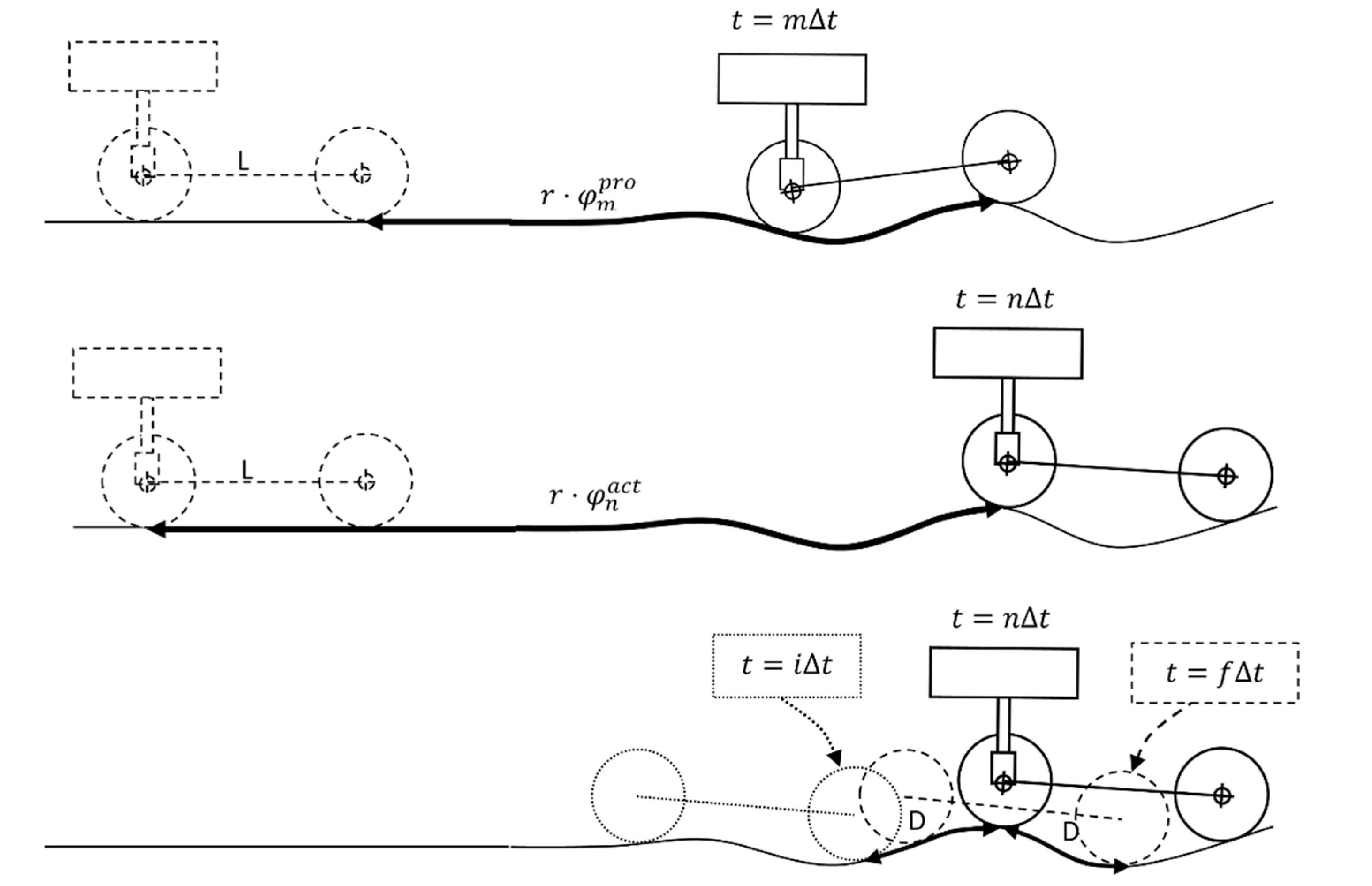


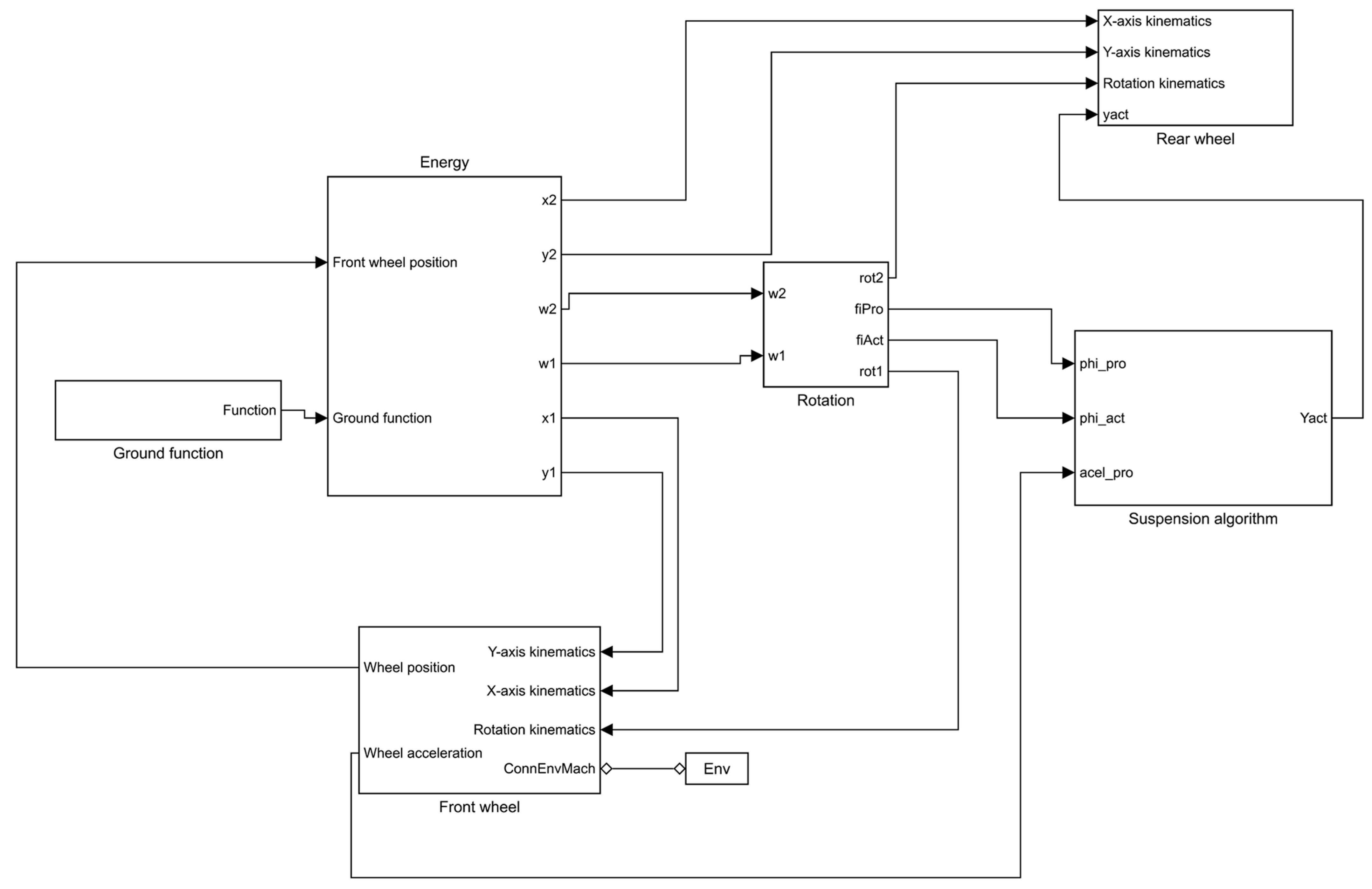
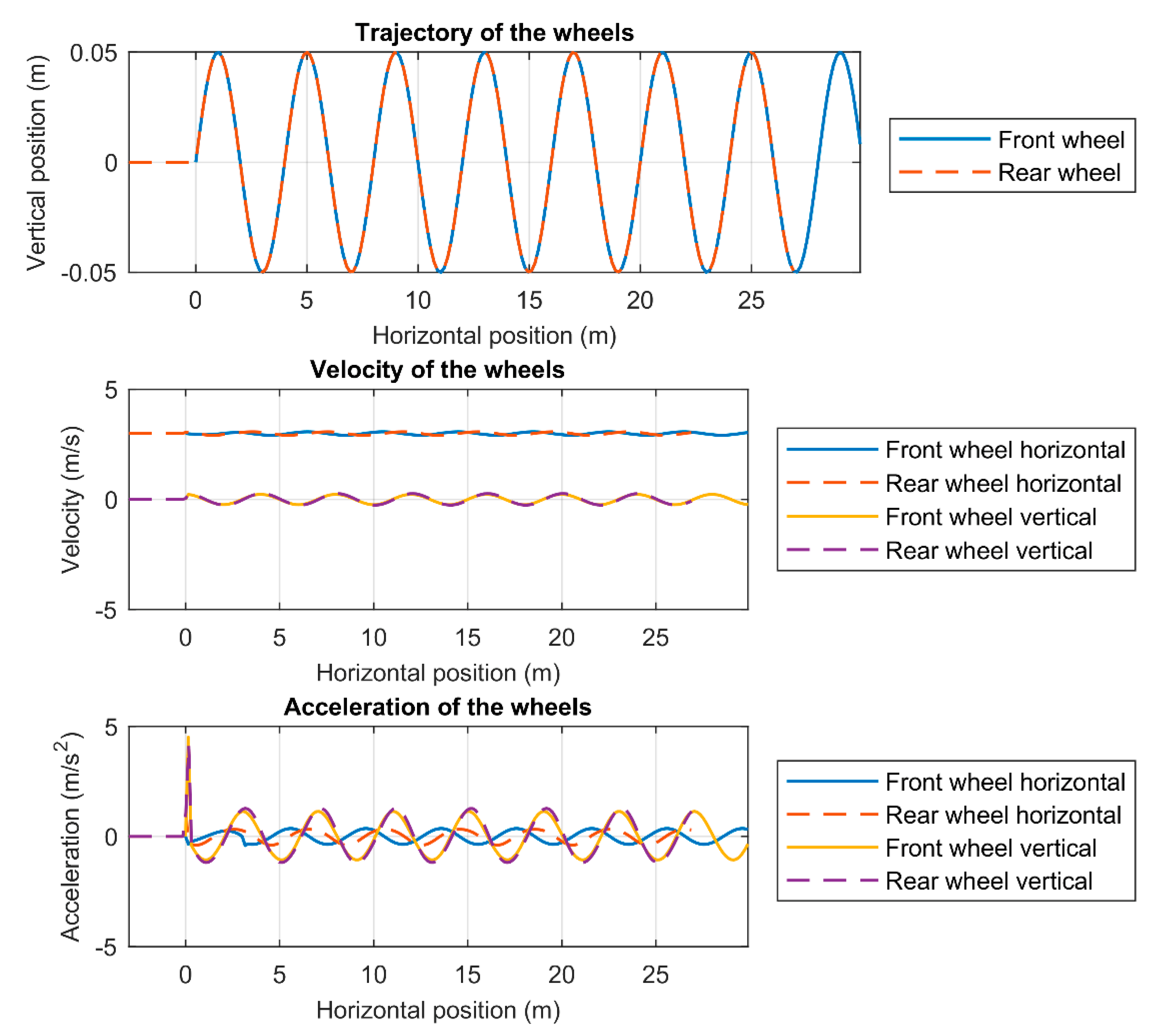
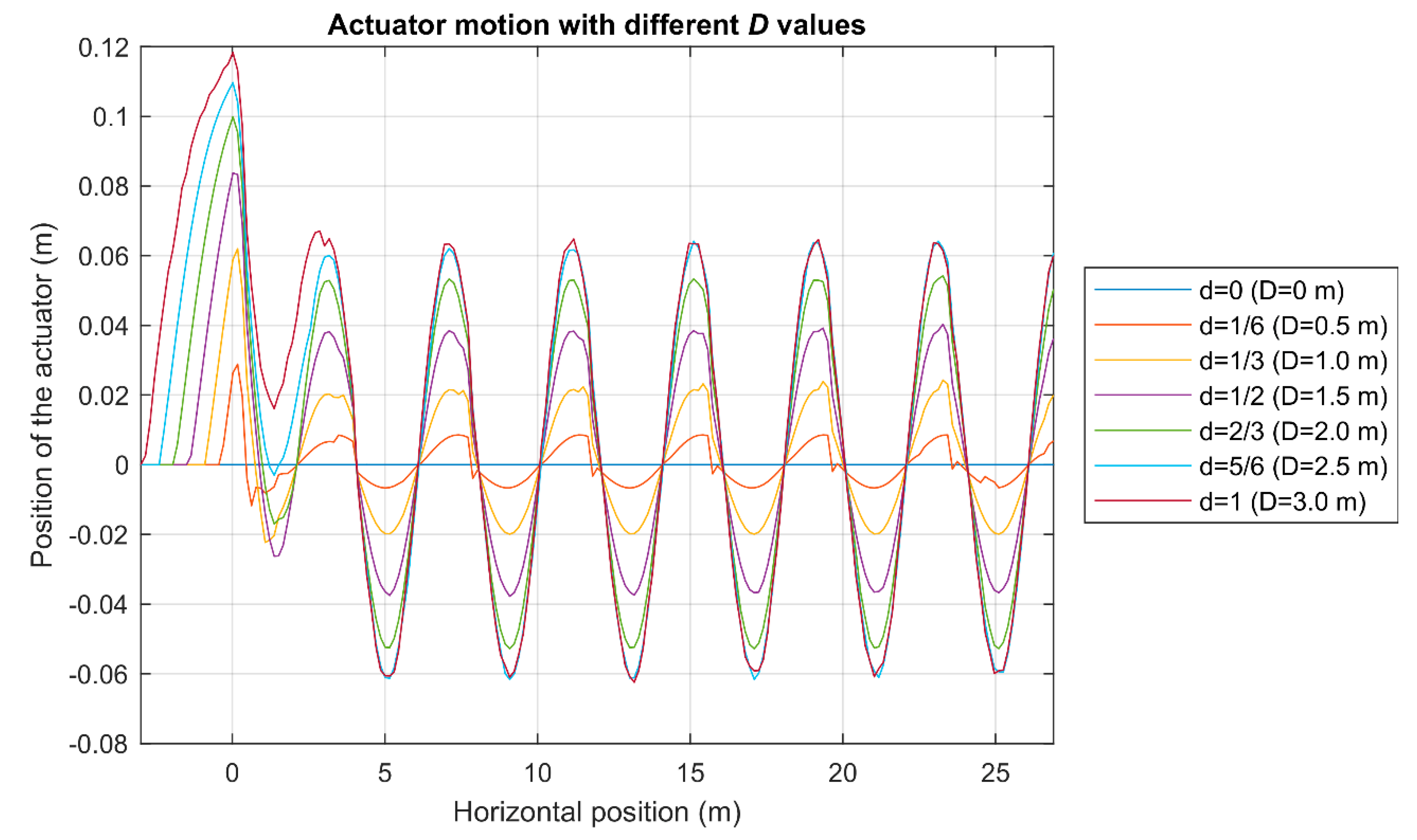


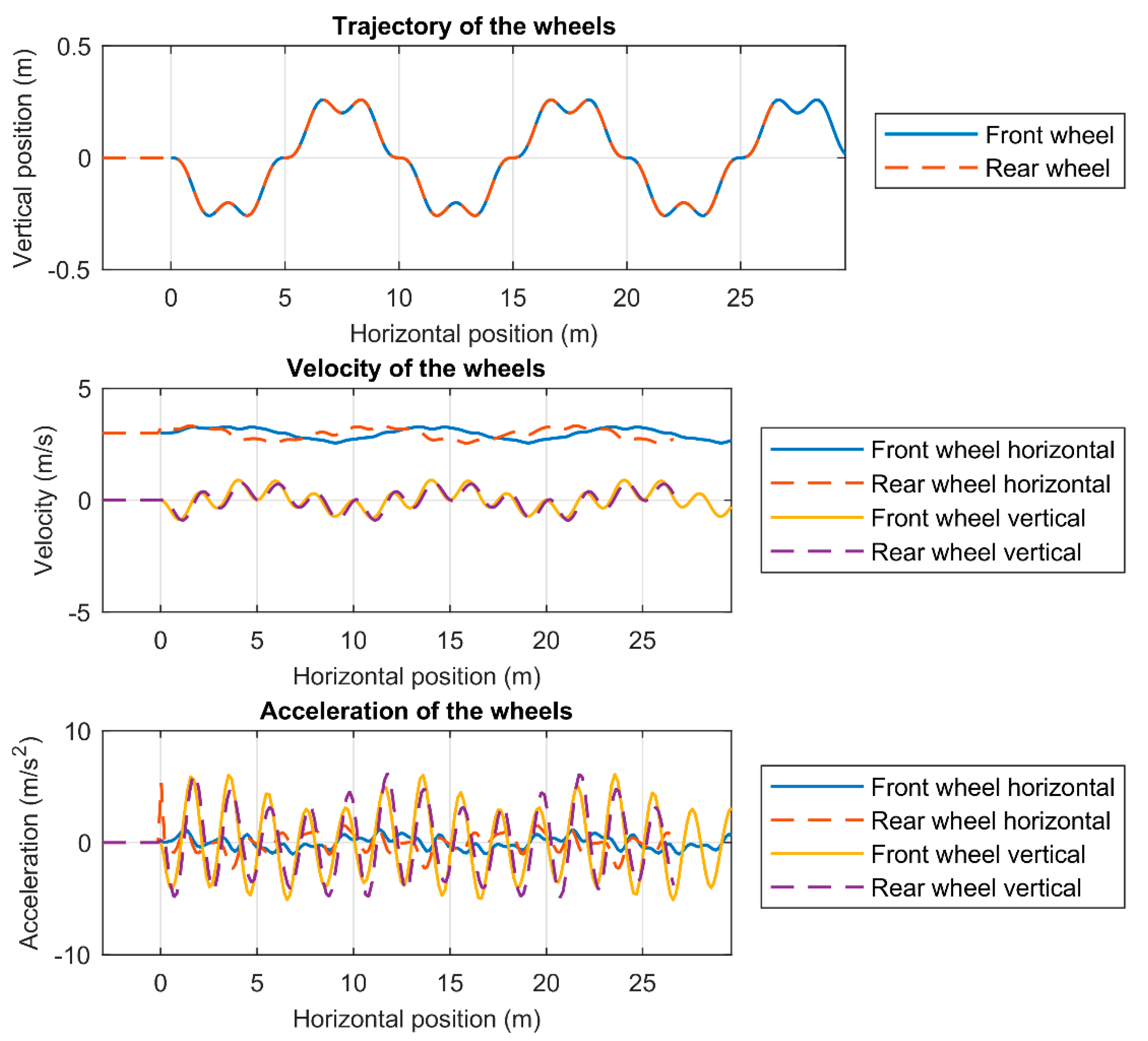
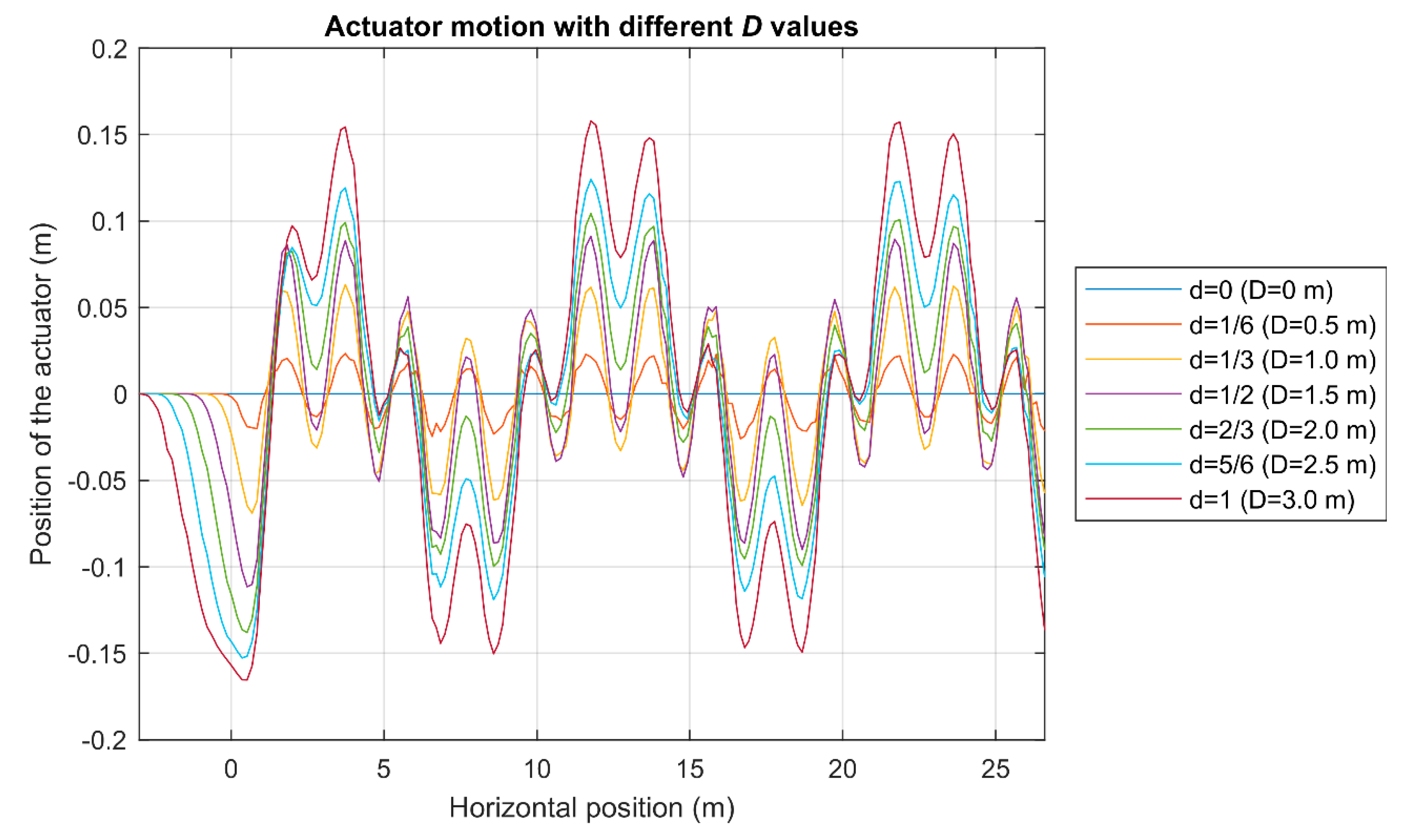

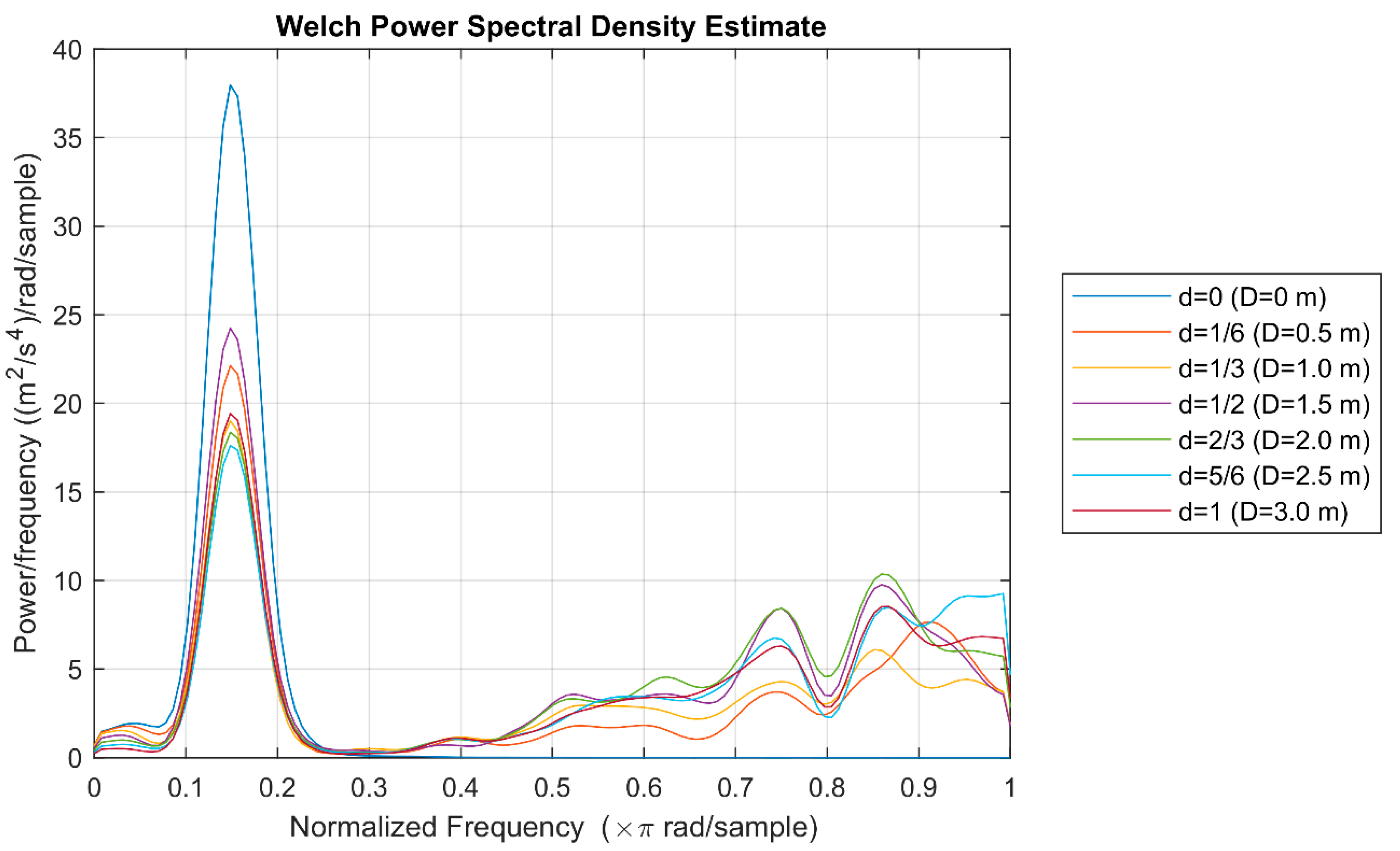
| Parameter | Value |
|---|---|
| Simulation time | 10 s |
| Horizontal velocity at t = 0 | 3 m/s |
| Vertical velocity at t = 0 | 0 m/s |
| Wheel diameter | 1 m |
| Wheel mass | 60 kg |
| Wheelbase | 3 m |
| Profile 1 | Profile 2 | ||
|---|---|---|---|
| Parameter | Value | Parameter | Value |
| A1 | 0.05 m | A1 | 0.05 m |
| λ1 | 4 m | λ1 | 2 m |
| A2 | −0.25 m | ||
| λ2 | 10 m | ||
| A0 | 0 m | ||
| a | 0 m | ||
| # Record | Probe Wheel Angle Turned | Actuated Wheel Angle Turned | Vertical Acceleration | Vertical Velocity | Vertical Position | Time |
|---|---|---|---|---|---|---|
| 1 | ||||||
| n |
| # Record | Angle Turned by Probe Wheel | Angle Turned by Actuated Wheel |
|---|---|---|
 | ||
| d = 0 | d = 1/6 | d = 1/3 | d = 1/2 | d = 2/3 | d = 5/6 | d = 1 | |
|---|---|---|---|---|---|---|---|
| Maximum | 2.8035 | 2.0397 | 1.2130 | 1.0728 | 1.0361 | 1.2695 | 2.1981 |
| RMS | 0.6057 | 0.9422 | 0.7551 | 0.6772 | 0.6728 | 0.7363 | 1.1141 |
| d = 0 | d = 1/6 | d = 1/3 | d = 1/2 | d = 2/3 | d = 5/6 | d = 1 | |
|---|---|---|---|---|---|---|---|
| Maximum | 37.9703 | 22.1259 | 19.0021 | 24.2496 | 18.3643 | 17.6156 | 19.4286 |
| RMS | 8.4317 | 5.6769 | 5.0129 | 6.7450 | 5.9922 | 5.7087 | 5.7104 |
Publisher’s Note: MDPI stays neutral with regard to jurisdictional claims in published maps and institutional affiliations. |
© 2022 by the authors. Licensee MDPI, Basel, Switzerland. This article is an open access article distributed under the terms and conditions of the Creative Commons Attribution (CC BY) license (https://creativecommons.org/licenses/by/4.0/).
Share and Cite
Bustos, A.; Meneses, J.; Rubio, H.; Soriano-Heras, E. Predictive Suspension Algorithm for Land Vehicles over Deterministic Topography. Mathematics 2022, 10, 1467. https://doi.org/10.3390/math10091467
Bustos A, Meneses J, Rubio H, Soriano-Heras E. Predictive Suspension Algorithm for Land Vehicles over Deterministic Topography. Mathematics. 2022; 10(9):1467. https://doi.org/10.3390/math10091467
Chicago/Turabian StyleBustos, Alejandro, Jesus Meneses, Higinio Rubio, and Enrique Soriano-Heras. 2022. "Predictive Suspension Algorithm for Land Vehicles over Deterministic Topography" Mathematics 10, no. 9: 1467. https://doi.org/10.3390/math10091467
APA StyleBustos, A., Meneses, J., Rubio, H., & Soriano-Heras, E. (2022). Predictive Suspension Algorithm for Land Vehicles over Deterministic Topography. Mathematics, 10(9), 1467. https://doi.org/10.3390/math10091467









